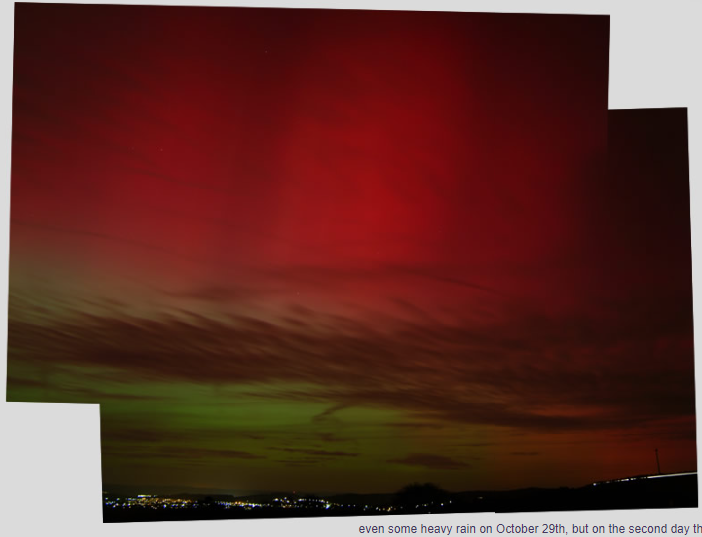Aurora, Trier, Germany
Aurora, Trier, Germany: A Spectacular Display of Nature's Light Show
In the late evening of October 30, 2003, residents of Trier, Germany were treated to a breathtaking display of natural beauty. This mesmerizing event was triggered by one of the most powerful solar eruptions ever recorded by the Solar and Heliospheric Observatory (SOHO) since its launch in 1995. As a result, an intense geomagnetic storm ensued, causing widespread disruptions and power outages. However, amidst the chaos, the skies over Trier were illuminated with vibrant and awe-inspiring aurorae.
The remarkable series of coronal mass ejections originating from sunspots 448 and 468 were the largest witnessed in 13 years. Their arrival, a full day earlier than expected, took scientists by surprise. The particle front reached Middle Europe in just 9 hours, heralding two consecutive nights of intense auroral activity. While the first night was unfortunately obscured by clouds and heavy rain, the second night revealed a stunning spectacle that captivated onlookers.
At approximately 21:40 on that fateful night, a luminous green glow appeared on the northern horizon of Trier. Gradually intensifying, it pierced through breaks in the clouds, casting an ethereal light on the landscape. By 22:15, vivid red auroral rays emerged, accompanied by yellowish or greenish veils near the horizon. Wispy whitish rays meandered through these vibrant colors, creating a truly magical scene. Despite Trier's relatively low latitude of 49.8°, the aurorae were so brilliantly bright that they effortlessly penetrated the thin cloud cover and even extended overhead.
As the night progressed, the aurorae gradually diminished in intensity, while the clouds began to reclaim the sky. By 22:45, the celestial display had faded into the background, leaving spectators in awe of the ephemeral beauty they had witnessed. The atmosphere was filled with a sense of wonder and gratitude for being able to witness such a rare and captivating event.
The occurrence of such a vivid aurora in Trier, located at a relatively low latitude, was truly exceptional. Typically, aurorae are more commonly associated with higher latitudes, closer to the Earth's magnetic poles. However, during periods of heightened solar activity, these mesmerizing displays can extend farther south, enchanting viewers in unexpected locations.
The intense geomagnetic storm that triggered the aurorae in Trier was a result of the interaction between the Sun's magnetic field and the Earth's magnetosphere. Coronal mass ejections release vast amounts of charged particles into space, which, when they reach Earth, interact with our planet's magnetic field. This interaction causes the particles to spiral along the magnetic field lines, ultimately colliding with atoms and molecules in the upper atmosphere. These collisions excite the atoms and molecules, causing them to emit light and create the mesmerizing colors of the aurora.
The aurora borealis (Northern Lights) and aurora australis (Southern Lights) are among nature's most captivating phenomena. They have fascinated humanity for centuries, inspiring myths, legends, and scientific exploration. These luminous displays remind us of the interconnectedness of our planet with the vastness of space and the dynamic forces at play in our universe.
The aurorae witnessed in Trier on that memorable night serve as a testament to the power and beauty of nature. They remind us of the wonders that can unfold when celestial events align with earthly conditions. The spectacle of the aurora is a gentle reminder of the vastness and complexity of our universe, urging us to appreciate and protect the delicate balance that sustains life on our planet.

Aurora, Trier, Germany
Imaged on October 30, 2003 by Eva Seidenfaden (Atmospheric Optics site).
"After one of the most powerful solar eruptions ever recorded by SOHO since it was brought into service in 1976, an extremely powerful geomagnetic storm occurred. A series of coronal mass ejections near sunspots 448 and 468, the largest in 13 years, caused radio and power blackouts. Satellites were shut down. The particle front arrived after only 9 hours, a day earlier than usual, and caused widespread very bright aurorae in Middle Europe over the next two nights. At Trier, it had been cloudy with even some heavy rain on October 29th, but on the second day the aurorae could easily be spotted. At 21:40, a green glow brightened the northern horizon and quickly got stronger, shining through the cloud holes. At 22:15, red auroral rays appeared, accompanied by yellowish or greenish veils near the horizon, with whitish rays wandering through them. Despite the .low. latitude of 49.8°, the aurorae were so bright they easily penetrated the thin clouds and even appeared overhead. At 22:45, the aurorae got fainter and the clouds began to cover the whole sky."
Note: this article has been automatically converted from the old site and may not appear as intended. You can find the original article here.
Reference Atmospheric Optics
If you use any of the definitions, information, or data presented on Atmospheric Optics, please copy the link or reference below to properly credit us as the reference source. Thank you!
-
<a href="https://atoptics.co.uk/blog/aurora-trier-germany/">Aurora, Trier, Germany</a>
-
"Aurora, Trier, Germany". Atmospheric Optics. Accessed on November 26, 2024. https://atoptics.co.uk/blog/aurora-trier-germany/.
-
"Aurora, Trier, Germany". Atmospheric Optics, https://atoptics.co.uk/blog/aurora-trier-germany/. Accessed 26 November, 2024
-
Aurora, Trier, Germany. Atmospheric Optics. Retrieved from https://atoptics.co.uk/blog/aurora-trier-germany/.